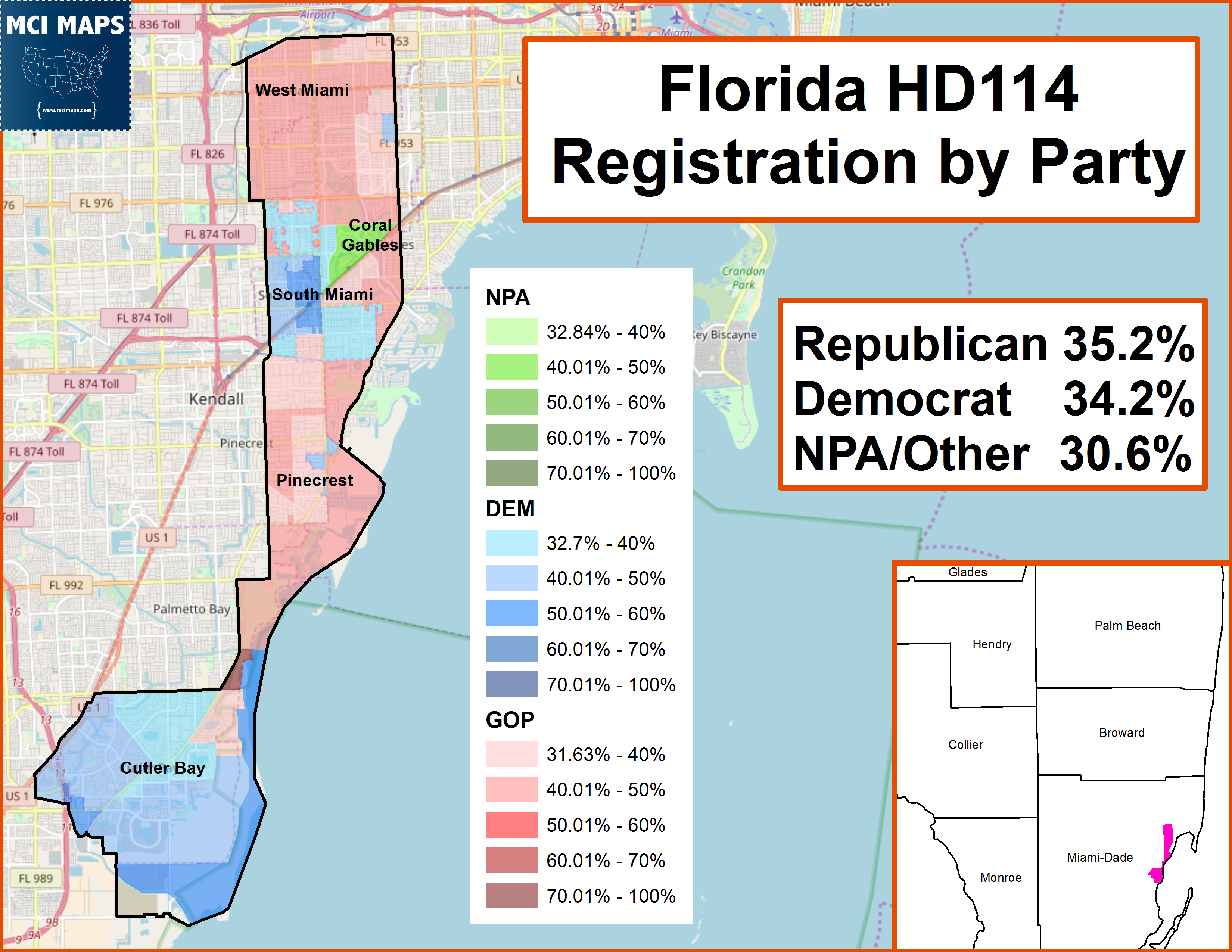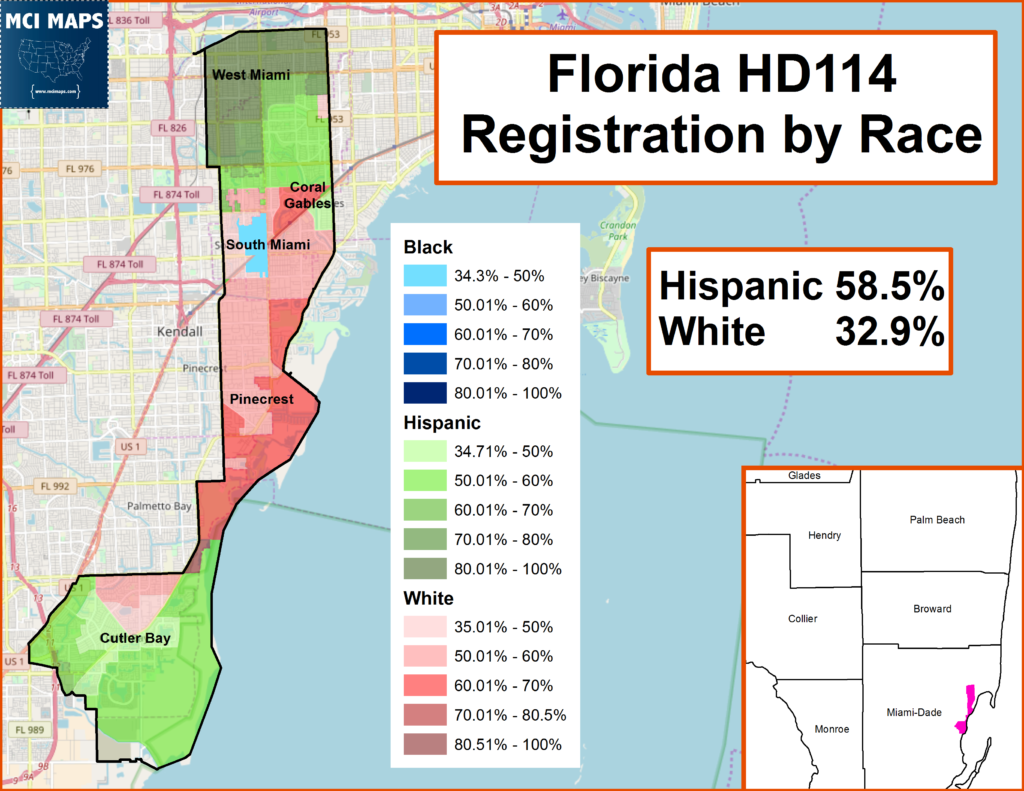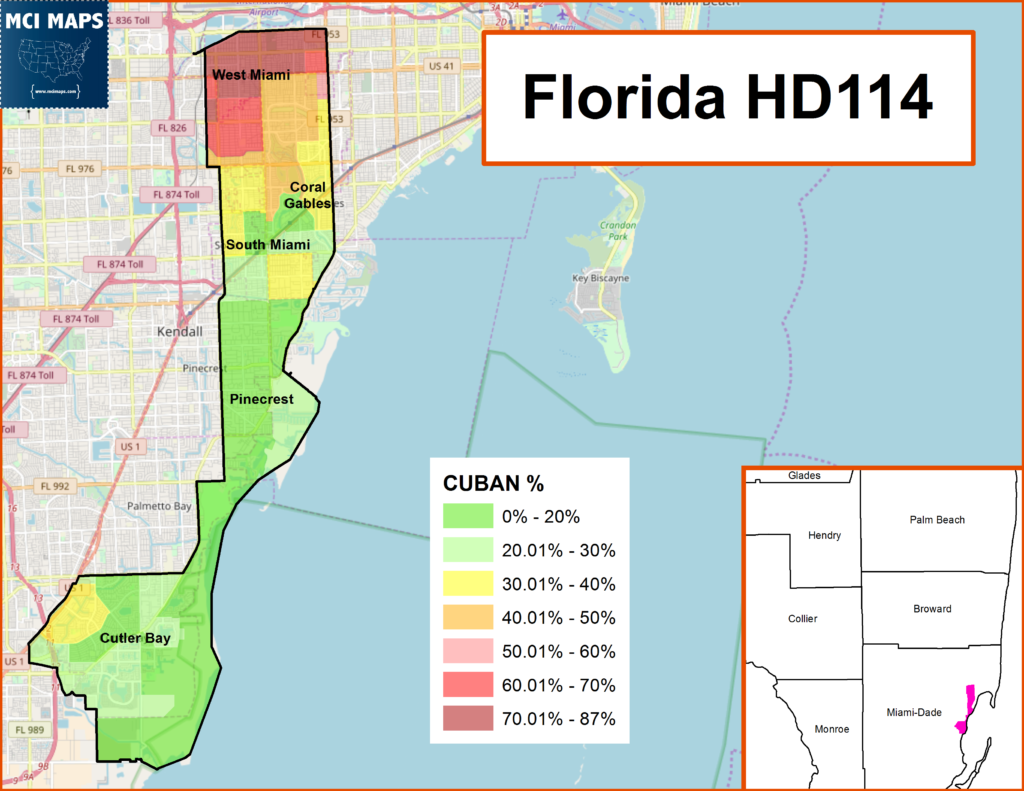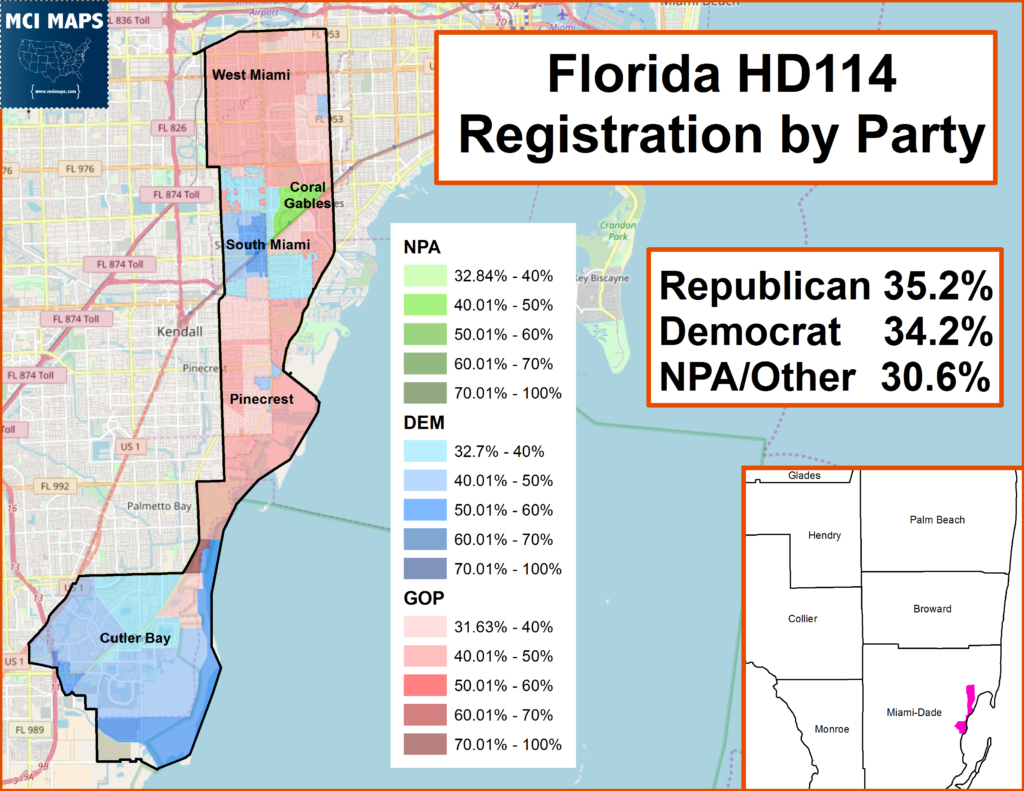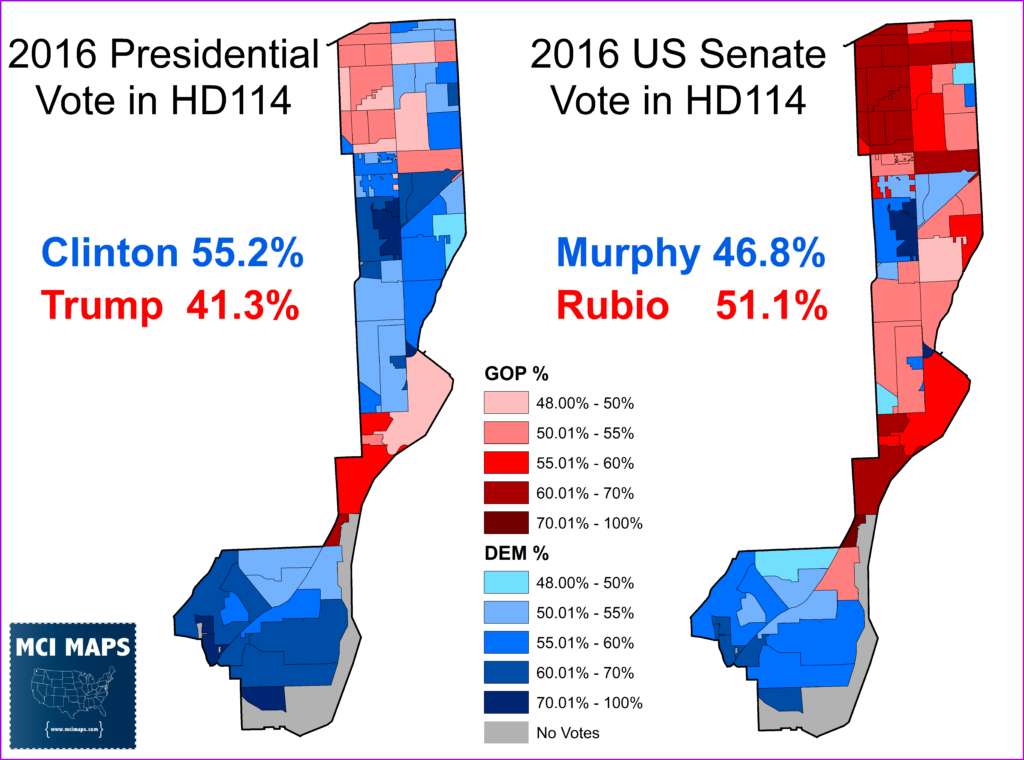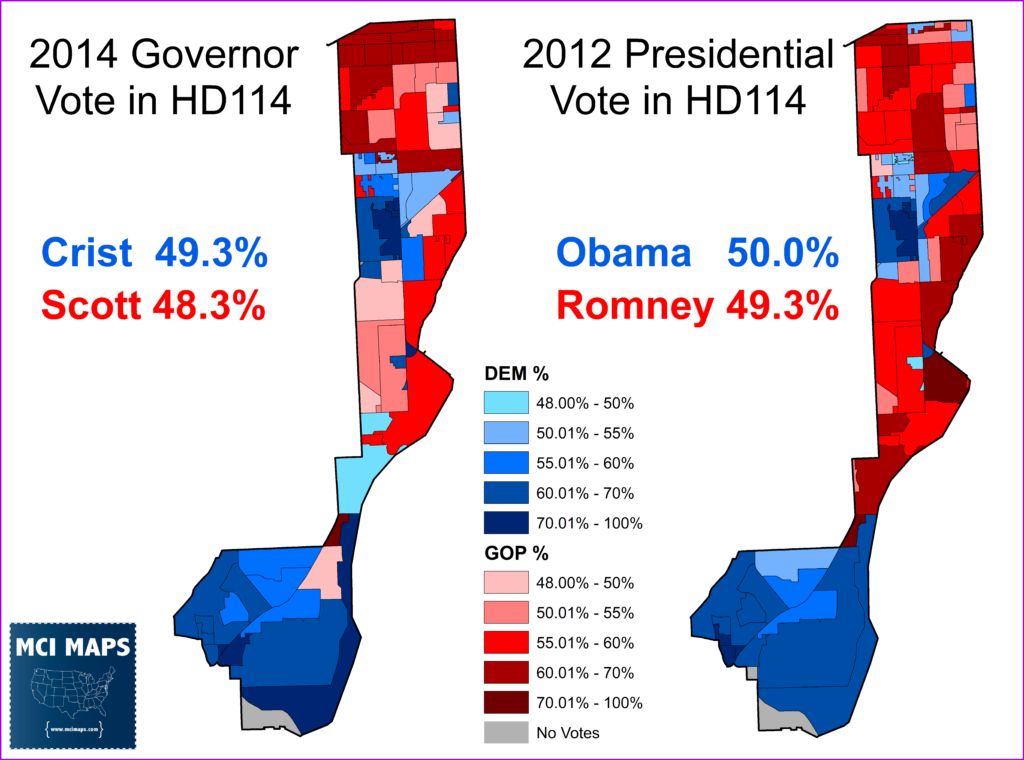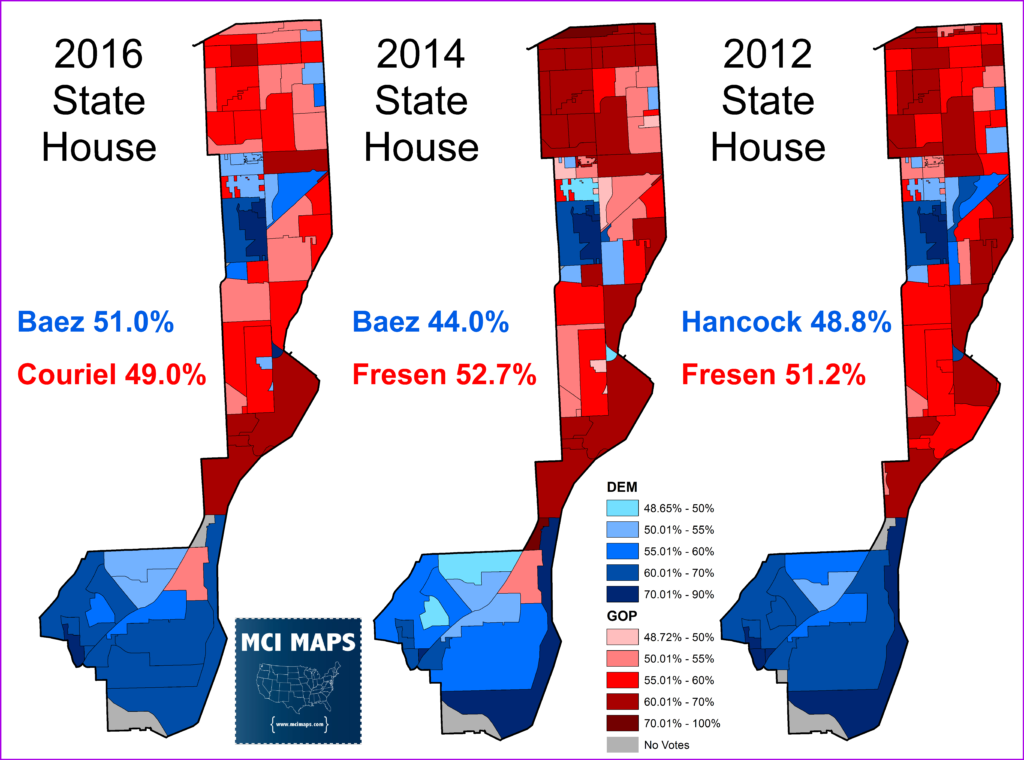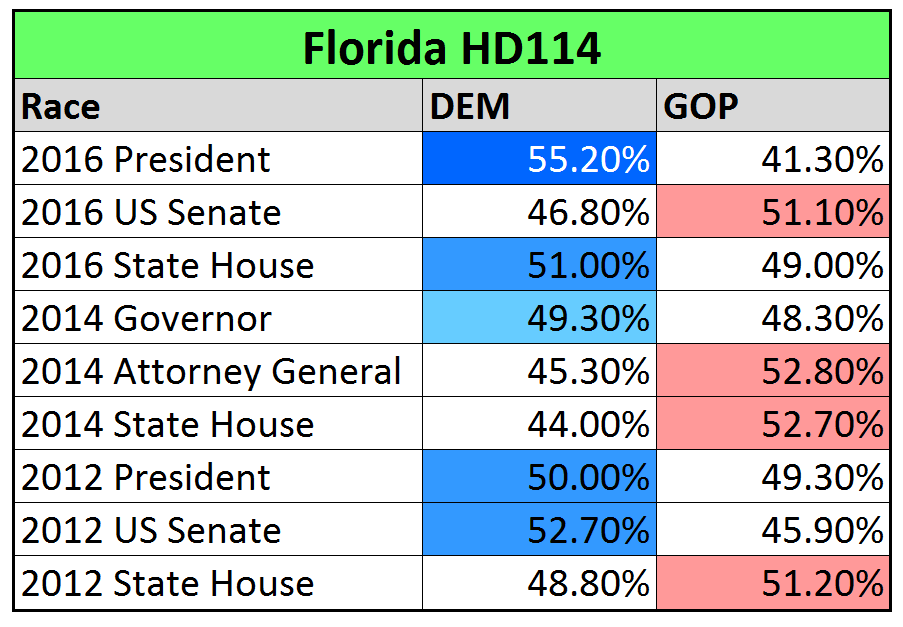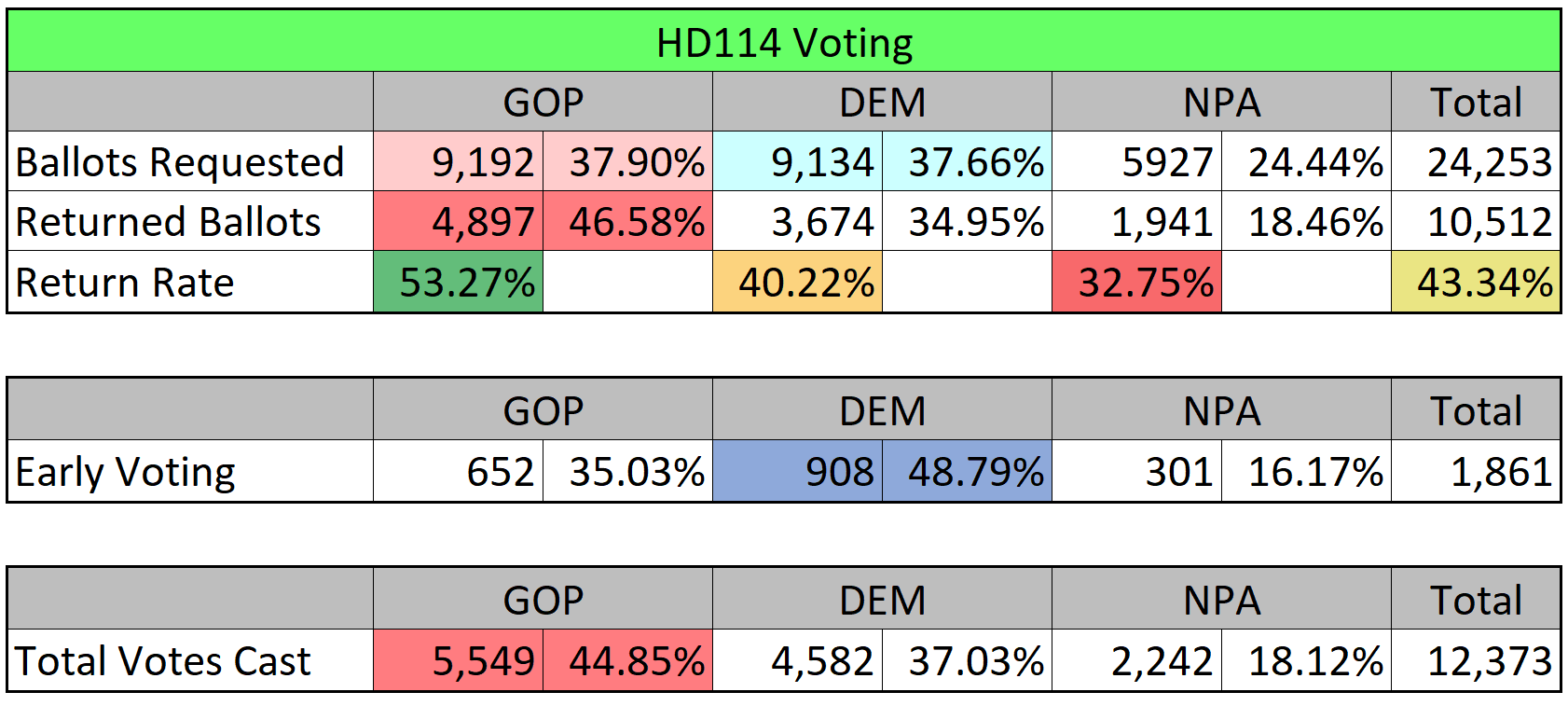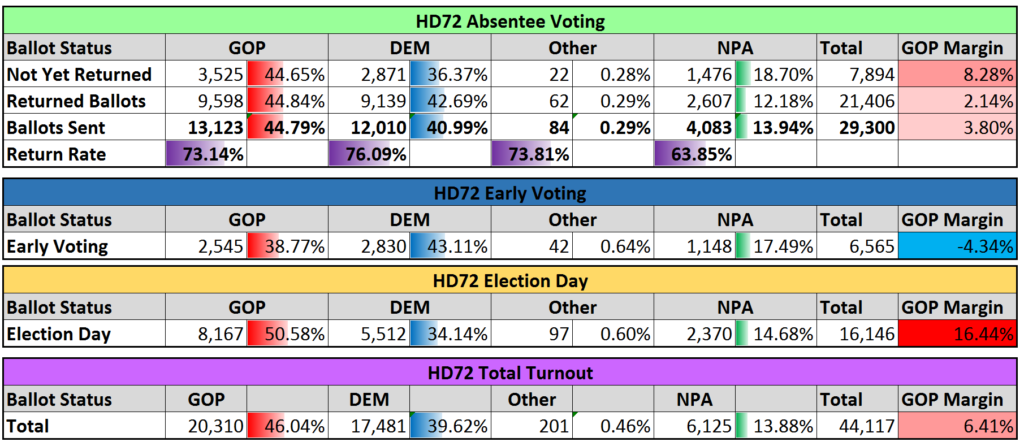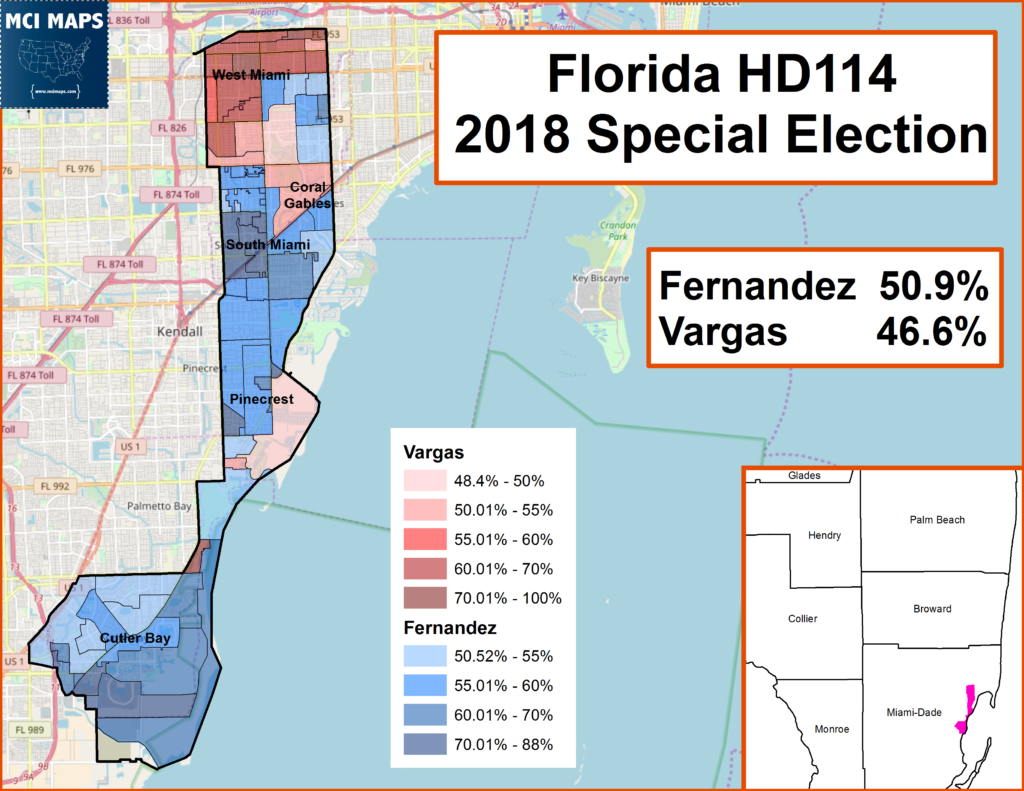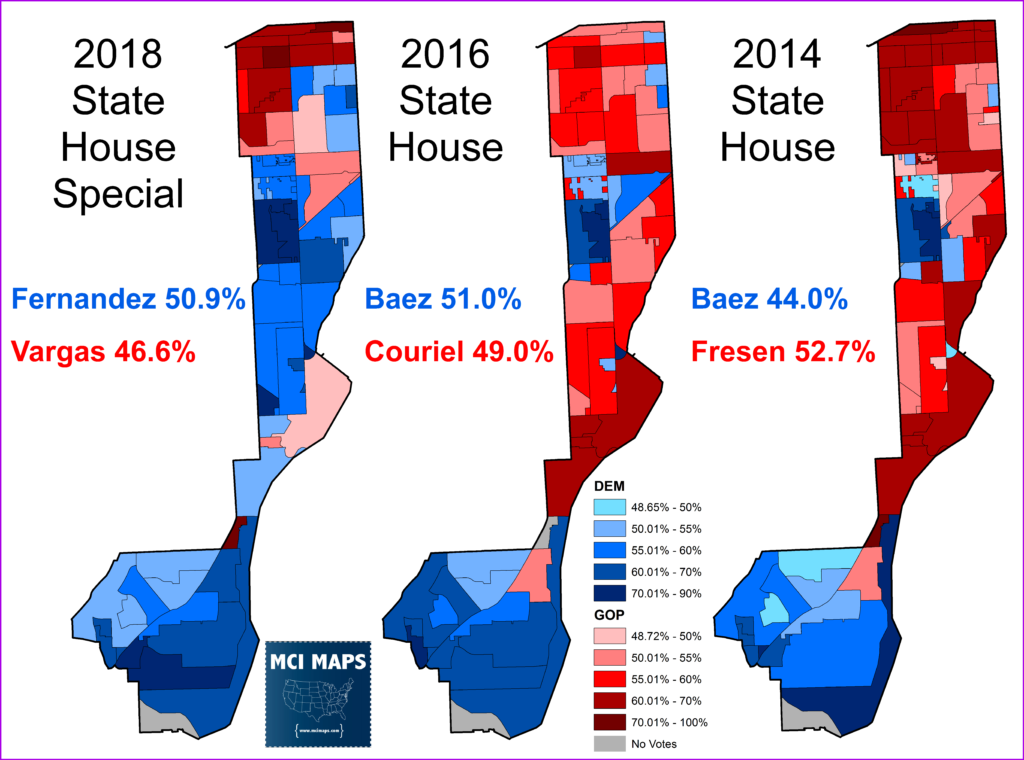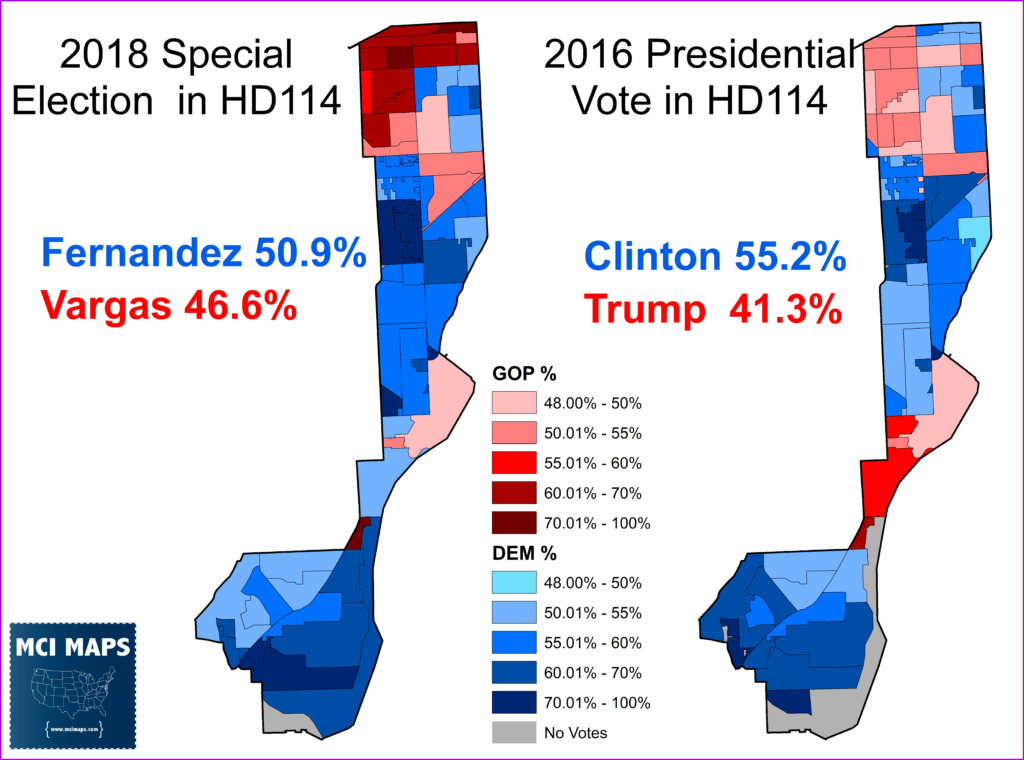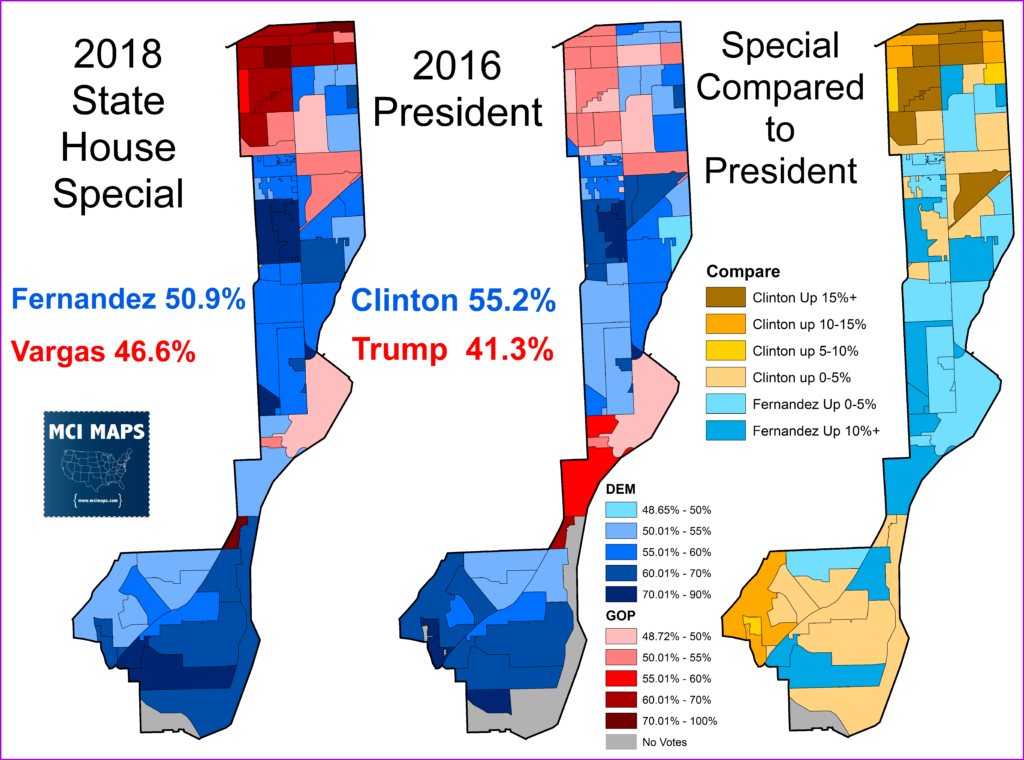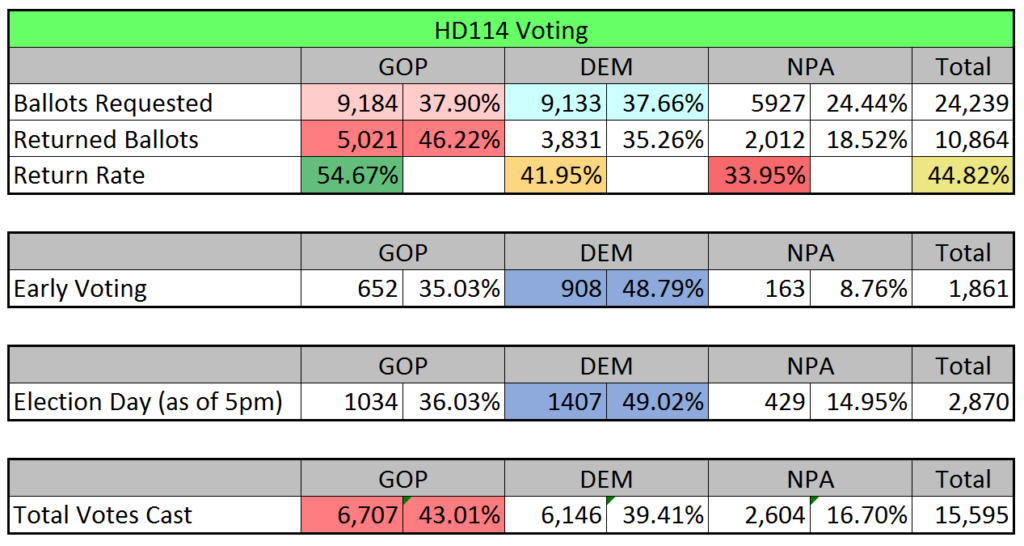May 1st will see the final state house special elections for Florida in the 2018 cycle. Two districts, HD39 and HD114 will be contested. While HD39 is a deep-red Trump+19 district, HD114 is a swing seat that is being fought over by both parties. The special election was trigger when Democrat Daisy Baez was forced to resign after pleading guilty to perjury in November. This was a seat Democrats had just won in 2016 and the special forces them to go on the defense. Regardless of who wins, the seat will be up again in November and likely see both parties aim for it then as well. The win here is more about bragging and momentum heading into the midterms. Democrats have come off pickups in HD72 and SD40, as well as a fierce defense for St Pete mayor. They hope to keep their momentum going by holding 114.
Demographics of HD114
HD114 is a Hispanic majority district based in the coast of Miami-Dade. It includes heavily Hispanic communities in West Miami and Cutler Bay; as well as whiter suburbs like Coral Gables and Pinecrest.
The district is a combination of higher end communities, particularly right along the coast, as well as some more modest income areas further inland. The whiter communities of Pinecrest and Coral Gables have median income over $120,000. These are communities, along with the Hispanic population, that gave Trump far less support than they gave Mitt Romney.
The district’s Cuban population is clustered more in the Northern end of the district.
Areas around West Miami are over 70% Cuban while the Hispanic population around Cutler Bay is more mixed.
Electoral History of HD114
House District 114 is a very divided district. It has trended blue at the Presidential level but registration and election results show a much more swingish district. Republicans narrowly edge out Democrats in the district, but overall the seat is a 3-way split; 35-34-30. Republicans are the plurality in Cuban-heavy West Miami and upper-income areas around Pinecrest and Palmetto Bay. Democrats have the edge in African-American South Miami and Hispanic Cutler Bay.
In 2016, the district swung hard toward Clinton. She got 55% of the vote compared to Trump’s 41%. This was a major improvement over Obama’s 1 point win four years earlier. However, the results were very much a factor of Trump’s unpopularity with Hispanics. Trump under performed in Cuban areas in the North; winning several precincts but by weaker margins. Meanwhile, Marco Rubio won the district by 5 points that same night. His Cuban margins were much stronger, as were his showing in upper-income white communities.
In the Murphy/Marco map, the only major Democratic areas are around South Miami and Cutler Bay.
Comparing the Presidential map to the 2014 Governor and 2012 Presidential shows how poorly Trump did with Cubans. Both Obama and Crist pulled off narrow wins in the seat. However, their maps are similar to Murphy’s 2016 loss. The Cuban community is solidly GOP and Crist/Obama rely on strong margins in Cutler Bay, South Miami, and Coral Gables.
At the state House level, the district has been fought over for the last three cycles. Democrats almost pulled off a dark-horse win in 2012 when Eric Fresen only narrowly fended off Ross Hancock. Democrats fought for the seat in 2014 and recruited Daisy Baez. Fresen held on in a red year and with a split on the left (when Hancock launched an indi bid). Baez finally won the open seat in 2016; outperforming Murphy but under performing Clinton.
Each result show a similar geographic pattern, one driven by ethnic groups and income.
Looking at each major race in the district on a table and we see the district splits its tickets frequently.
The district may look blue when only focusing on the Presidential results. However, down-ticket voting shows a solid purple seat.
Current Special Election
When Daisy Baez was forced to resign, it created a vacancy. Governor Scott had discretion in whether to call a special election. By that point, any special would have taken place after the last day of the 2018 legislative session. A few vacancies that occurred shortly after did not have specials called. However, a special was called for HD114 and HD39. The district is widely considered more favorable for Republicans in a special thanks to their inherent advantage with absentee returns in Hispanic communities. Cuban voters often vote absentee and have strong return rates. In specials, absentees are the most popular voting method. The special gives the GOP a chance to win the seat and have incumbency going into the fall. The race has been contested by both parties but it has not received the attention that HD72 or SD40 received.
Early voting so far paints a favorable picture for Republicans. They have a stronger absentee return rate, and as a result lead in absentee returns by 1,200 voters. Democrats, meanwhile, only have a modest in-person early vote advantage, which narrowed the gap to 1,000.
The 7.5% gap between the GOP and Democrats isn’t insurmountable for team blue, but it requires strong turnout on election day from their base.
Democrats have been in this position before. In the SD40 special election last year (just west of this seat) the GOP led in absentee voting. Early voting had closed the gap a bit. However, it took election day to tie turnout.
Democrats went on to win that seat by 3 points. For Democrats though, the question is if they can pull off stronger election day margins and get election day to be a decent share of the vote. The Democrats are in a slightly bigger hole than they were in SD40.
Democrats may not need equal shares to win. When they picked up HD72 a few months back, they did so while the GOP’s share of the electorate was 6 points higher.
Of course that was Sarasota and this is Miami-Dade. Democrats won HD72 thanks to suburban Republicans defecting and backing the Democrat. It is not clear how many Republicans would do that in Dade. Each county’s voters is different.
Democrats do not have the same heavy ground game they had in the SD40 special election. Major outside groups came in for that race. This time its a much smaller affair. HOUSE VICTORY – the campaign arm for Florida House Democrats, says they have knocked on over 35,000 doors as of a few days ago and that they are continuing to do GOTV through election day.
For democrats, it will come down to how election day goes; not just in the share that is Democratic but how many raw voters show up. Expect to see the GOP lead in absentee voting. If absentees are razor close, that means we are seeing GOP defections and NPAs heavily backing the Democrats. Both would be bad signs for the GOP in the fall.
However, if election day turnout does not manifest and Democrats let this seat slip away, it will show that enthusiasm is not enough. It will show major investment is needed in different district to actually generate wins.
Updated Results
The results are in the Democrats have held onto district 114. Democrat Javier Fernandez edged Republican Andrew Vargas by 4 points, 50.9% to 46.6%.
Fernandez’s four-point win was higher than any other Democratic showing in a state house race for the seat. On top of that, Fernandez won more precincts than post house candidates, doing better in parts of Pinecrest and South Miami. The heavily Cuban West Miami precincts were solidly for Vargas, his only major base of support.
Fernandez didn’t do as well as Hillary Clinton, but this was too be expected. Clinton’s margin was inflated by Trump’s severe dislike in Cuban communities. As the 2016 map shows, Trump was weak in the Northern Cuban precincts.
Clinton outperformed Fernandez in the Northern Cuban precincts as well as Hispanic Cutler Bay in the South. However, Fernandez did outperform Clinton in whiter communities in the district like Pinecrest, as well as African-American South Miami.
Fernandez was able to pull off the win thanks to strong Democratic turnout on election day. The figures below show election day turnout as of 5pm (we dont have the final list from the elections department yet). Election Day as democratic as in-person early voting, but with far more votes cast. Democrats were able to narrow the turnout advantage the GOP had built up with absentees. Total election day votes came to around 3,900 voters.
Looking at how the race broke down by voting method shows Fernandez won early voting and election day solidly. Comparing the candidate shares to the partisan makeup a few key patterns emerge.
Based on the data, absentees indicate parties remained largely loyal and absentees broke fairly evenly. This makes sense considering absentee were more Hispanic and Cuban. Meanwhile, early voting and election day voting were more diverse. Based on how much Fernandez over-performed Democratic share, its clear NPAs broke heavily for the Democrats as well as a notable share of Republicans splitting off and voting Democratic.

